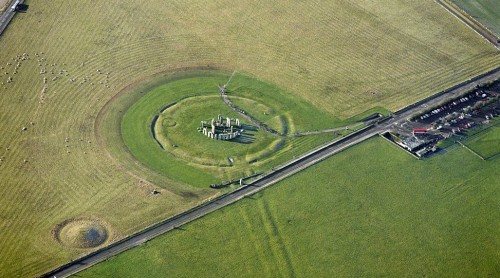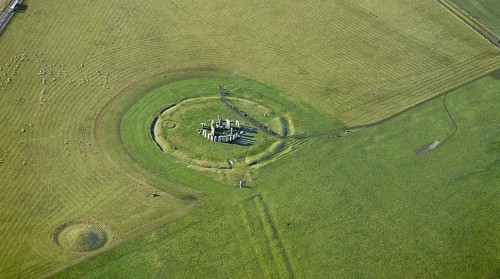Computer generated images of new buildings and urban landscapes have long been a bit of an annoyance for me (and many people) in how the images rendered are rarely realistic representations of how the building will look when finished.
Always be suspicious of computer-generated images of the buildings at dusk, as that is when most modern glassy buildings look their best. And even then, there is a suspicious lack of office clutter piled up next to the glass walls in such renders.
Likewise, wind farms in rural areas look a lot smaller on the company graphics, and much larger on opposition graphics.
But I think a prize needs to be given to English Heritage today for quite literally making the grass greener following some building work.
The ugly road that runs right next to Stonehenge has closed today — and will shortly by torn up and buried under grass. A new subterranean visitor center will also be constructed.
All of which leaves the stones more isolated and alone in the landscape — which is to be applauded.
In the computer renders of the before/after images, I couldn’t help but notice that the grass also gets greener around the sheep in the distance.
Nope – it’s not an optical illusion such as this — they really have coloured the grass to make it greener.
I had no idea that removing a road could have that effect.
—
Incidentally, while visitors are normally kept away from the stones, did you know you can go inside the stones themselves?
If you can muster up a group, you can book the stones for an hour in the evening after all the tourists have left and have the whole place to yourself.
I did that a few years ago – a really quite exceptional experience.









Re your last comment: instead of booking the evening, you can go at the solstices and not only enter the circle, but touch the stones over the course of 13 hours, for the princely sum of £0. 🙂 A very worthwhile experience. You’re not alone, but the atmosphere created by all the druids, spiritualists and like-minded tourists just adds to the whole thing.
I grew up in Wiltshire, and in those days a visit to Stonehenge was a close-up walk through the stones – today’s “distance-viewing” is very disappointing if you have actually been inside the stone circles. But I have been looking forward to the closure of the A344 ever since viewing the exhibition of the new scheme in the Wellington Arch last year (blogged by Ian 10/5/2012). – there is nothing worse (apart of course from being corralled outside the stone circles) than walking the surrounding landscape and having the final approach up the Avenue to the stones blocked by chain link fencing. I am eagerly looking forward to visit when the new order has been established – shame they couldn’t finance the hiding of the A303 as well though !
Isn’t there a plan to tunnel the A303 one day in the future?
Amazing that anyone ever thought that a road that close to the monument was a good idea – but I guess people didn’t think about ancient history back then, much like that Mayan temple that was recently used as hardcore in Mexico.
And that’s a terrible attempt at photoshopping a road out of a photo.
Old prints show that what is now the A303-A344 junction has existed from time immemorial as tracks across Salisbury Plain – a fascinating picture of the junction in the 1930’s, complete with AA box and cottages now demolished, is at https://www.facebook.com/photo.php?fbid=10150847648845748&set=a.10150847648035748.402121.173240995747&type=1&theater. I think the A303 tunnel plan was abandoned years ago on cost grounds – the present scheme was luck to survive as well.
The A303 predates Stonehenge, though of course it was only relatively recently the prehistoric road was given that designation and made suitable for automobiles.
Stonehenge was built there because of its good transport links.
So in a sense, complaining about a major road being next to your ancient monument is like opening a hotel next to Heathrow to take advantage of the patronage and then complaining how insensitive it is that Heathrow should douse your establishment with noise.
The tunnelling plans have been on-again-off-again for many years. Maybe the success of the A3 Hindhead tunnel might renew momentum.
if that monster link doesn’t work – look through the pics at the English Heritage Facebook page for Stonehenge – https://www.facebook.com/pages/Stonehenge/170137036344463
that gives a picture of the original old tracks as well